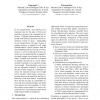Free Online Productivity Tools
i2Speak
i2Symbol
i2OCR
iTex2Img
iWeb2Print
iWeb2Shot
i2Type
iPdf2Split
iPdf2Merge
i2Bopomofo
i2Arabic
i2Style
i2Image
i2PDF
iLatex2Rtf
Sci2ools
EMNLP
2007
2007
Scalable Term Selection for Text Categorization
In text categorization, term selection is an important step for the sake of both categorization accuracy and computational efficiency. Different dimensionalities are expected under different practical resource restrictions of time or space. Traditionally in text categorization, the same scoring or ranking criterion is adopted for all target dimensionalities, which considers both the discriminability and the coverage of a term, such as χ2 or IG. In this paper, the poor accuracy at a low dimensionality is imputed to the small average vector length of the documents. Scalable term selection is proposed to optimize the term set at a given dimensionality according to an expected average vector length. Discriminability and coverage are separately measured; by adjusting the ratio of their weights in a combined criterion, the expected average vector length can be reached, which means a good compromise between the specificity and the exhaustivity of the term subset. Experiments show that the...
Average Vector Length | EMNLP 2007 | Expected Average Vector | Natural Language Processing | Term Selection |
| Added | 29 Oct 2010 |
| Updated | 29 Oct 2010 |
| Type | Conference |
| Year | 2007 |
| Where | EMNLP |
| Authors | Jingyang Li, Maosong Sun |
Comments (0)

